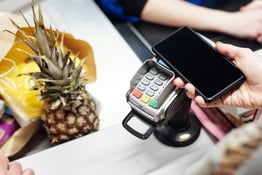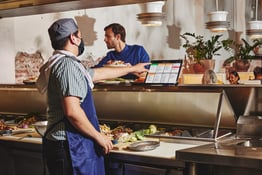Goodbye paper tickets (and lost tickets), hello efficiency-enhancing technology.
More and more restaurants are ditching the handwritten legacy method of managing orders for Kitchen Display Systems (KDS), a technology-driven ordering software that has the potential to transform operations.
We break down what a KDS is, its primary advantages, and suggestions for how to make the transition.
What is a Kitchen Display System (KDS)?
A KDS is a digital order viewing screen that’s placed in the kitchen. Often kitchens will have multiple screens mounted near different stations (the fry station, sauté station, expo area, etc.).
It gets integrated with your point-of-sale (POS) system so that once a server enters an order, the KDS automatically routes it to the appropriate kitchen stations where orders appear on the monitor.
Most modern systems include functionalities like organizing dishes according to prep and cook times, notifying staff when an order’s in the queue for too long, and the ability to program coursing rules.
Why invest in a KDS?
Most consider investing in a KDS a no-brainer.
“It’s a win-win situation. The initial investment sometimes holds people back, but I don’t see any other major drawbacks,” says Ronald Blum, Jr. an associate professor at Johnson & Wales University who specializes in hospitality technology.
KDS prices vary, but typically include an upfront cost for the hardware and a monthly subscription fee averaging between $12 to $30. Many current POS systems offer KDS upgrades as part of their monthly subscription, and sometimes the hardware is interchangeable.
While it’s among what feels like an infinite number of monthly fees, a KDS subscription cuts other costs, like paper and ink of a traditional impact printer. “Now you have a screen where you can often have up to 10 orders on one screen, so that’s not only saving all that paper from going to the landfill, but if you have multiple restaurants, it can make a significant impact to your yearly expenses,” says Blum.
Even if you’re operating as an independent and the upfront savings are nominal, a KDS has vast potential to improve efficiency. Here are a few highlights of how it can help:
Reduction in errors: Since everything with a KDS is digital, there’s no chance of losing tickets, even during your busiest hours.
Better communication between FOH and BOH: With a KDS, customer requests, like “no cheese” or “ vinaigrette on the side”, aren’t just scribbled notes that sometimes get missed or misinterpreted. Waitstaff can also enter last minute changes into the POS after an order’s already rung in, and they’ll automatically show up on the ticket. This minimizes confusion, along with chaos in the kitchen, negating the need for a server to run in and shout a change. With the POS integration, front of house staff can also see dish statuses and prepare to run food as soon as it’s ready.
Increased consistency and tightened ticket times: Most systems allow you to program color-coding that signals how long an order’s been in the queue. This can enhance quality control and motivate staff to stay within standard cooking times. “Just like a traffic light, green means it’s time to start the order, yellow is a visual alert that you need to prioritize that ticket, and red tells you it’s moved beyond the standard cooking time and people are waiting,” says Blum.
Automatic food sequencing and easier pacing: Modern KDS systems give you the ability to program dish sequencing and cook times. Each dish is prioritized accordingly, creating automatic and consistent pacing for the server and food that’s served at its ideal temperature. As an example, once a server rings an order into the POS, the KDS knows to immediately cue firing for the appetizer. It also sends the medium-well steak to the grill section, but the fryer won’t get cued for the fries until just before the order’s ready to go. “In the past, you’d have a coordinator who could only do all of this as best as they can, but this makes mistakes almost eliminated,” says Blum.
Data at your fingertips to help optimize operations: A KDS creates a digital record of your kitchen operations, including average speed of service and cook times, so that you can access and analyze the data at any time. This helps identify where there’s room for improvement and if you might need to staff up.
How do I transition to a KDS?
It doesn’t matter if you’re a 100-seat restaurant or a small coffee shop – KDS systems can benefit nearly every restaurant, says Blum, and there are plenty of options to choose from. “Even if you’re a food truck, Square, for example, has a compact KDS about the size of the iPad that can be easily mounted anywhere in the truck,” says Blum.
Start by talking to your current POS company and see if they offer a KDS package and at what price. If so, ask for an overview on the system’s specific features, along with whether the investment includes training and if you’ll be responsible for most of the programming.
If the process feels intimidating, start small.
“Get one KDS, and have the main person working your line continue to coordinate the food, but through seeing it on a screen instead of paper, and you can expand from there,” says Blum. “It may be a little bit different of an approach, but this isn’t just a trend, it’s here for the long run.”
Grace Dickinson is a reporter at Back of House. Send tips or inquiries to grace@backofhouse.io.
[Photo courtesy Square]





